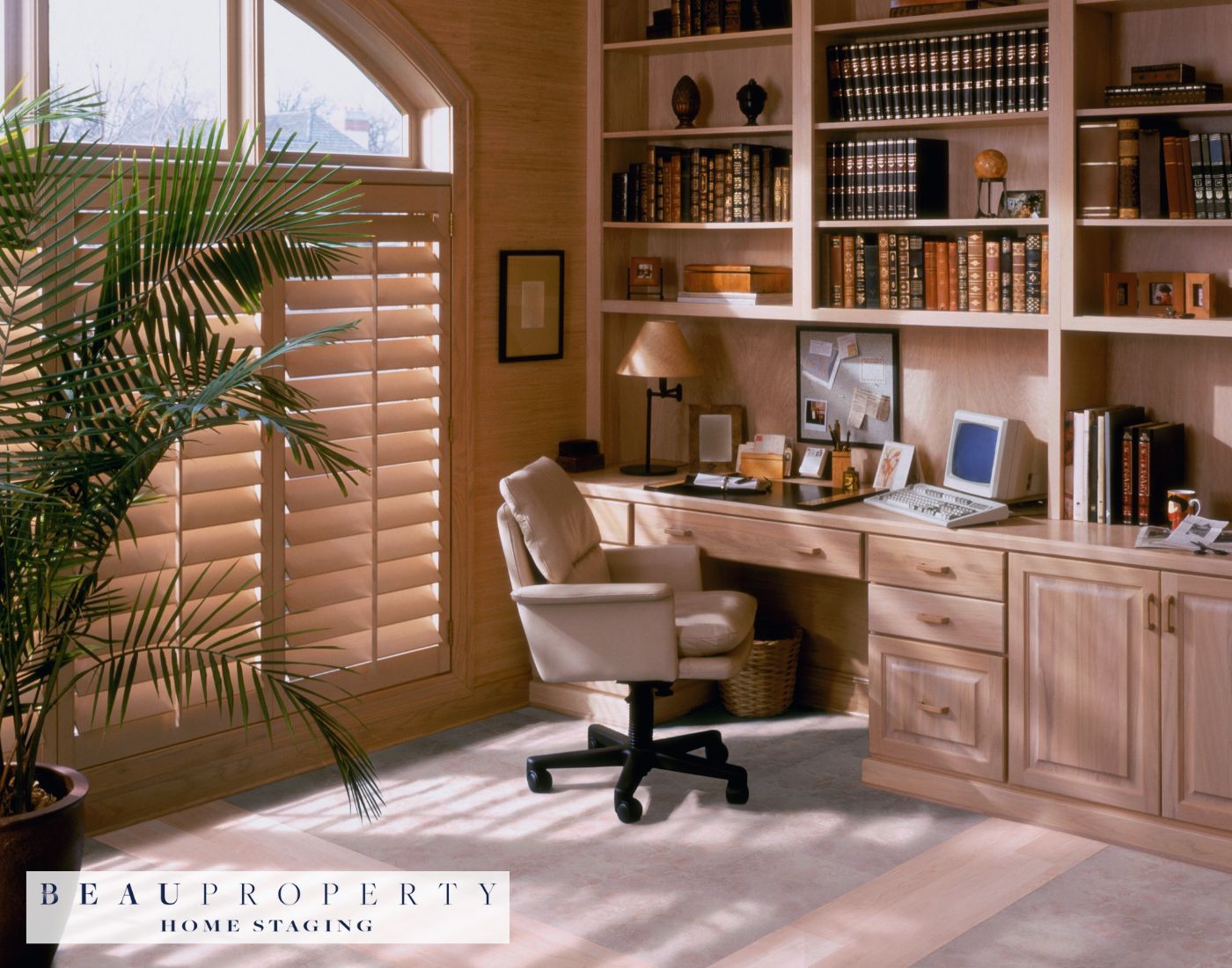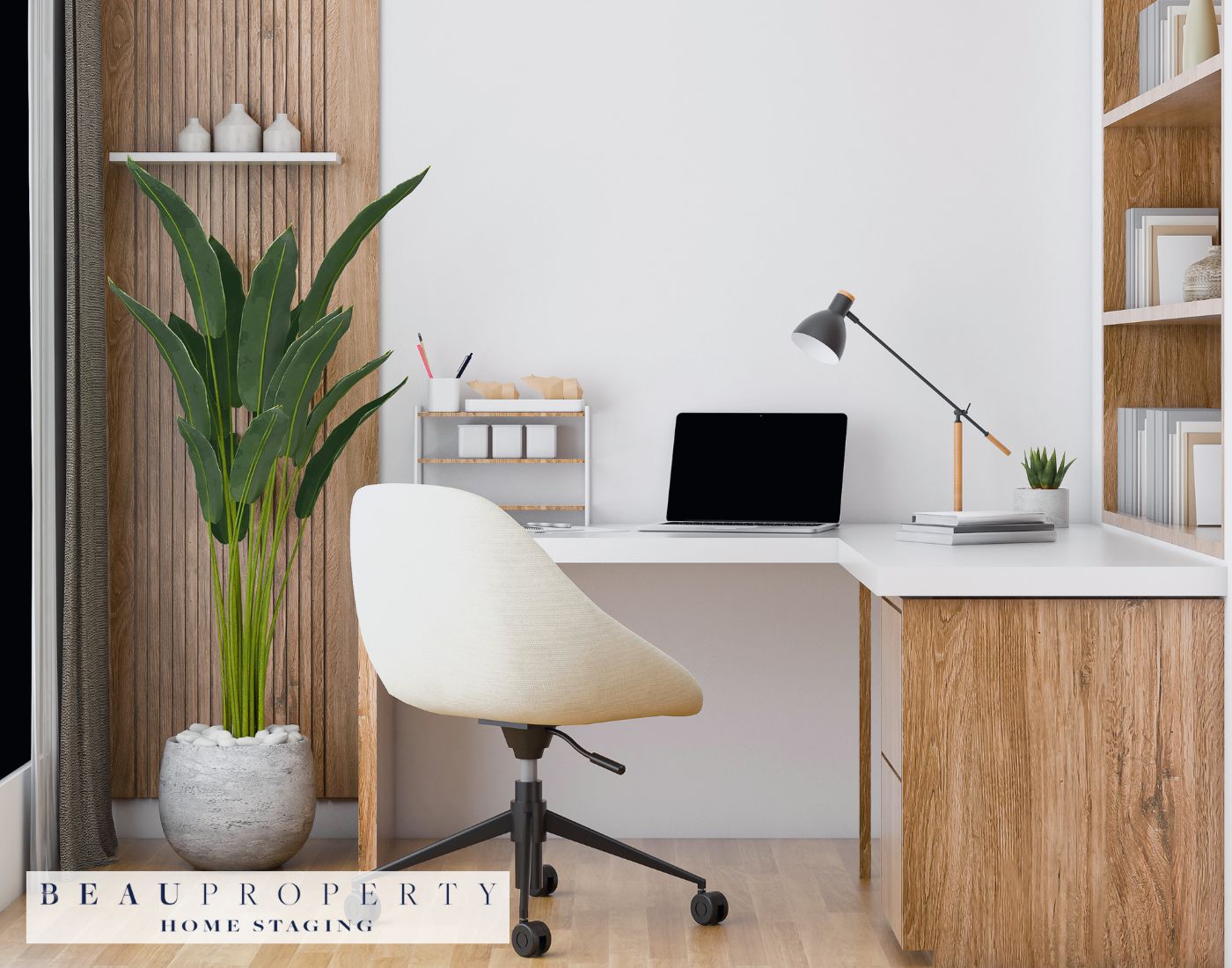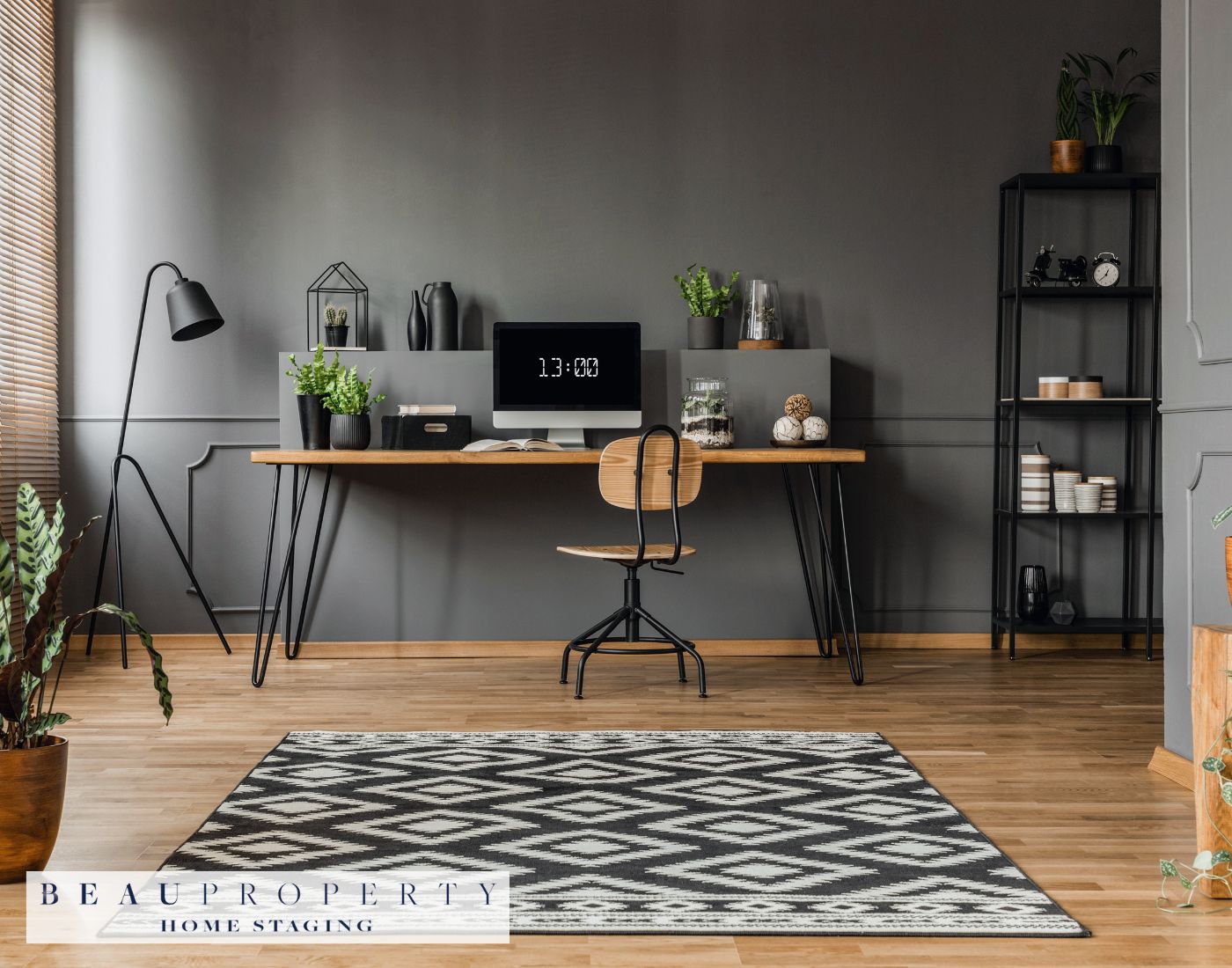Introduction to Home Office Staging
Defining Home Office Staging
Home office staging is a specialised segment of home staging, focusing on preparing a home office to appeal to potential buyers. It involves redecorating, rearranging furniture, and cleaning, along with other aesthetic strategies, to create an environment that showcases the space’s potential as an efficient and attractive workspace. The goal is to provide a visually appealing and functional area that can help buyers envision themselves working from the office, thus enhancing the property’s overall appeal.
Importance in Today’s Real Estate Market
With the rise of remote work and flexible working arrangements, home offices have become a significant selling point in today’s real estate market. Buyers now prioritise homes that offer dedicated, well-designed workspaces. A properly staged home office can set a property apart from others, making it more enticing to potential buyers who might otherwise overlook it. Showcasing a home office that appears ready-to-use and inviting can influence buyers’ decisions positively, as they can picture themselves seamlessly transitioning into that space.
Impact on Potential Buyers
Home staging in general has a proven record of positively impacting buyer perception. Staging is designed to showcase a home’s best assets, impress buyers, and sell it quickly for the highest possible price. A well-staged home office does more than just look good; it helps buyers to visualise how they can utilise the space effectively.
Moreover, a staged home office can create an emotional connection with buyers. This emotional connection is crucial as it enables potential buyers to see the home as their future abode—a place where they can live and work comfortably. Even in a seller’s market, staging a property can directly influence a buyer’s decision to view the home in person and submit an offer.
Economic Benefits
Economically, staging a home, including the home office, can lead to faster sales and potentially higher offers. Staged homes spend 73% less time on the market compared to non-staged homes. Additionally, a staged home can increase the sale price of the home on average anywhere from 1-10%, according to 50% of real estate agents surveyed.
Considering these statistics, investing in home office staging is a wise decision for sellers looking to maximise their return on investment. A well-staged home office can highlight the home’s versatility, thereby increasing its overall marketability.
A well-staged home office helps buyers to visualise themselves working productively in the space. This can significantly influence their purchasing decision and create a competitive advantage for the seller. Hence, the impact of a well-staged home office extends beyond mere aesthetics; it contributes substantially to the home’s marketability and appeal, ultimately aiding in a quicker sale at a potentially higher price.
Decluttering and Organising the Space
Effective home office staging begins with a clean and organised workspace. Potential buyers often envision themselves using the space, and clutter can severely detract from the appeal. Here are tips to help you declutter and organise, creating a space that balances form and function.
Removing Unnecessary Items
Decluttering is the first step to creating a tidy workspace. Follow these strategies to efficiently clear out unnecessary items:
- Remove Everything: Empty the office entirely. This gives you a fresh perspective and helps detach sentiment from items.
- Sort by Categories: Identify what stays and what goes by sorting items into categories such as office supplies, electronics, and personal items. For non-essential papers and knickknacks, use categories like ‘donate’, ‘recycle’, ‘dispose’, and ‘relocate’.
- Tackle the Easiest First: Start with the simplest items. Discard obvious trash and remove redundant items. This makes the process less overwhelming and builds momentum.
- Declutter the Floor and Surfaces: Keep only essential furniture on the floor. Clear desk surfaces by removing excess papers and gadgets.
Organising Documents and Tech Equipment
Once you’ve cleared out the extra clutter, the next step is to streamline the organisation of documents and technical equipment.
Documents
- Colour-Code Your Filing System: Use coloured folders to categorise documents intuitively. This makes it easier to locate important files quickly.
- Regularly Purge Files: Establish a routine to go through and dispose of or digitise unnecessary documents. Shred sensitive information to protect privacy.
- Digital Solutions: Consider digitising physical documents to save space. Label digital files consistently and store them in a secure cloud system.
Technology Equipment
- Organise Cables and Tech Accessories: Use cable organisers or velcro ties to manage wires and keep them out of sight. Maintain a designated spot for frequently used tech accessories like chargers and adapters.
- Create a Charging Station: A centralised charging station can keep devices charged and cords tidy. It also prevents the space from looking cluttered with various charging equipment.
- Use Dividers and Shelves: Efficiently use dividers within drawers and open shelves to store smaller tech items. This makes accessing them easier and keeps the workspace neat.
Creating a clutter-free and well-organised home office sets the stage for the next crucial aspect of staging—selecting the right furniture and layout to enhance ergonomics and aesthetics. The importance of a clutter-free space can’t be overstated, as it paves the way for a harmonious and functional environment.
Choosing the Right Furniture and Layout
Selecting Ergonomic and Stylish Furniture
When staging a home office, selecting the right furniture is paramount for both aesthetics and functionality. The first aspect to consider is ergonomics. An ergonomic workstation enhances comfort and supports productivity, and its importance can’t be overstated. Opt for a desk that aligns with your height, allowing enough wiggle room. If you’re using a desktop, ensure the desk has enough depth for your monitor and keyboard, typically around 28 to 30 inches high, which is suitable for most users.
Chairs should offer excellent lumbar support, be adjustable, and have a comfortable seat cushion. The right chair can make a significant difference in productivity and overall well-being. Look for those with adjustable armrests and backrests to accommodate various body types and postures.
When choosing furniture, don’t compromise on style. Ensure the pieces reflect the room’s design and the home’s overall decor. For traditional homes, wooden desks and softer, plush chairs work well. Contemporary homes might benefit from sleek, metal desks and artistic seating. Selecting materials that are both durable and stylish ensures long-lasting and visually appealing furniture.
Arranging Furniture to Maximise Space and Flow
The layout of your home office can greatly influence the room’s functionality and perceived space. Start by keeping the entryway clear of bulky furniture to create a sense of openness. Position your desk to make use of natural light; ideally, place it facing a window or with the door in view.
Balance the room by distributing furniture evenly. Avoid crowding all pieces against the walls, which can make the space feel constricted. Instead, place larger pieces, like desks and shelving units, against the walls and leave central areas open to maintain a good traffic flow.
Visual balance is key to a harmonious workspace. Arrange furniture to create zones within the office. For instance, a reading or meeting nook with a couple of chairs placed near a bookshelf can serve as an inviting focal point and a collaborative space. This setup not only breaks the monotony of a single desk but also makes the office multipurpose.
Paths should be clear of obstacles to enhance movement and accessibility. Consider using rugs to define different zones within the room without creating physical barriers. Storage solutions like wall-mounted shelves or under-desk filing systems can help maintain an uncluttered look without sacrificing functionality.
As you arrange your home office, maintain flexibility. Adjustable furniture and modular pieces can easily be reconfigured to suit different needs, whether that’s accommodating a visiting client or shifting to a new task.
By choosing ergonomic and stylish furniture and strategically arranging them, you create a functional, appealing workspace that enhances productivity and adds value to your home. The next step involves choosing the right colours and lighting to complete the ambience of your staged home office.
Colour Schemes and Lighting
The Psychological Impact of Colour in a Workspace
Colour plays a significant role in influencing mood, behaviour, and productivity within a workspace. Understanding the psychological effects of colour can help create an environment that fosters productivity and well-being.
Warm Colours:
- Red, Orange, and Yellow: These hues are associated with energy, excitement, and activity. Red can stimulate vigorous emotions and create a sense of urgency, which might be beneficial in high-energy areas but should be used sparingly in the general workspace to avoid overstimulation. Yellow is known for promoting optimism and enhancing creativity, making it suitable for brainstorming areas. Orange exudes enthusiasm and high activity levels, benefiting collaborative spaces.
Cool Colours:
- Blue, Green, and Purple: These tones are linked with calmness, tranquillity, and focus. Blue is especially potent in promoting a stable and serene environment, enhancing focus and productivity. Green, reminiscent of nature, not only creates a relaxed atmosphere but also reduces eye strain. Purple, although less commonly used, brings a sense of quality and boosts cognitive functions.
Neutral Colours:
- White and Grey: Neutral tones offer a clean and airy feel but must be balanced to avoid creating an overly sterile or dull environment. Incorporating elements with warm undertones can add sophistication while maintaining a professional appearance.
Choosing Appropriate Lighting
Lighting is essential to both the aesthetics and functionality of a workspace. Proper lighting can significantly impact productivity and the overall well-being of individuals using the space.
Natural Light:
- Natural light is unrivalled in boosting mood, energy levels, and overall productivity. Encouraging as much natural light as possible is beneficial, whether through large windows or skylights. Natural daylight also helps in maintaining circadian rhythms, which are crucial for health and work performance.
Artificial Lighting:
- For times when natural light isn’t sufficient, the use of blue-enriched lighting can simulate daylight and enhance cognitive functions and alertness. LED lights are advisable due to their similarity to natural light along with their energy efficiency.
- Avoid warm, yellowish hues in general workspaces as they are more conducive to relaxation and might hinder productivity. These can be reserved for break rooms or lounge areas where relaxation is the goal.
- Ensure even distribution of light to avoid harsh shadows and glare, which can cause eye strain and reduce productivity. Task lighting, such as desk lamps, can provide focused illumination for specific activities, enhancing visibility and reducing fatigue.
Employing the right colour schemes and lighting can transform a workspace into a haven of productivity and well-being. By strategically selecting colours that enhance desired psychological states and ensuring proper lighting, you craft an environment that supports optimal work habits and overall satisfaction.
Accessorising and Personal Touches
Creating a Cohesive Look
When accessorising a home office, the goal is to enhance the decor without adding personalisation. Start by choosing items that complement the overall aesthetic of the space. Neutral tones like taupe, beige, or ivory create a serene atmosphere and can blend seamlessly with various styles. Adding accessories in these shades ensures a cohesive look without appealing to specific tastes.
Thoughtful Accessorising
Decorating your home office with the right accessories can significantly impact its appeal to potential buyers. Here’s how to do it thoughtfully:
- Lighting
Incorporate a stylish yet functional desk lamp or floor lamp. Lamps from home can add a touch of personality and warmth. - Area Rugs
An area rug can inject some energy into the space without being too personal. Choose a rug in a neutral colour or subtle pattern to add texture and demarcate the office area. - Wall Art
Select framed prints or artwork that reflect a professional yet inviting atmosphere. Motivational quotes, abstract art, or landscape photographs serve the purpose well. These can define the workspace without making it feel overly personal. - Greenery
Adding easy-care plants such as succulents can bring a touch of nature indoors, creating a calming environment. When live plants aren’t practical, high-quality faux greenery is an excellent alternative. - Functional Decor
Items like stylish bookends, neutral storage boxes, and sleek pen holders can enhance both aesthetics and functionality. Repurpose kitchen glassware for desktop organisation or use fun frames for a pop of character.
Using Decorative Items Effectively
Accessories should enhance the professional feel of the home office without adding clutter:
- Pictures and Frames
Opt for a few tastefully framed images that match the room’s colour scheme. This can be abstract artwork or calming landscapes, which are appealing and non-distracting. - Organisational Elements
Use decorative organisers to keep the workspace tidy. Items like stylish trays, elegant wire baskets for papers, and minimalist shelves can make the space both practical and pleasing. - Textiles and Soft Furnishings
Introduce textile elements like throw pillows and small blankets in neutral colours. This not only makes the space feel more inviting but also adds a layer of comfort. - Glassware and Mason Jars
Glass jars can serve as stylish containers for pens, pencils, or small plants. Repurposing these items adds a unique touch without compromising on a neutral palette.
Ensuring Neutrality
To appeal to a broad audience, it’s crucial to maintain neutrality. Avoid personalised items such as family photos, monogrammed accessories, or personal collections. Stick to decor that is stylish but impersonal, ensuring that potential buyers can envision their own items in the space.
By thoughtfully selecting and arranging accessories, you can transform a home office into an attractive selling point. This approach not only improves the room’s functionality but also enhances its visual appeal, helping buyers to see themselves working productively in the space.
Conclusion: The Benefits of Professional Home Office Staging
Enhanced Buyer Perception and Appeal
One of the most significant benefits of professional home office staging is its ability to enhance buyer perception. By transforming a mundane room into a polished, functional workspace, staging helps potential buyers visualise themselves working efficiently in the space. This visualisation is crucial for making an emotional connection, which can significantly influence a buyer’s decision.
Quicker Sales and Higher Prices
Professional home office staging often results in quicker sales. Over 25% of Realtors indicated that staged homes sell faster. Furthermore, the same source suggests that staged homes generally fetch higher prices than non-staged homes because they look more appealing and well-maintained. This phenomenon results in a compelling return on investment (ROI) for homeowners. A staged home spends 73% less time on the market than an unstaged one, demonstrating the tangible benefits of staging.
Facilitates Home Appraisals
Home staging can also positively influence appraisals. Staging helps appraisers see the property in its best light. When homes are staged, they appear more functional, clean, and appealing, making it easier for appraisers to attribute a higher value to them.
Minimal Investment for Maximum Impact
While staging does require some upfront investment, the costs are generally overshadowed by the benefits. Services like Beau Property Staging offer tailored packages that cater to different budget levels, making it accessible for most homeowners. These services can highlight key spaces, help properties stand out in a crowded market, and make homes look well-maintained. This strategic investment often results in a higher sale price, validating the initial expenditure.
Improved Marketability
Professionally staged home offices elevate the overall marketability of the property. In a competitive real estate market, having a well-staged home office can act as a unique selling point. Even in a seller’s market, staging provides the highest return on investment and enhances overall marketability, ensuring that your property captures buyers’ attention immediately.
Contribution to a Clutter-Free Environment
Finally, professional staging services transform cluttered and disorganised offices into streamlined, functional workspaces. Decluttering and organising not only improve the aesthetic appeal but also contribute to a more serene and productive environment. Buyers can better appreciate the office’s potential without being distracted by unnecessary items.
To summarise, staging a home office brings numerous benefits, from enhancing buyer perception and speeding up sales to increasing the sale price and improving marketability. Considering professional staging services like Beau Property Staging can amplify these benefits, making your property more attractive to potential buyers and leading to better offers.








